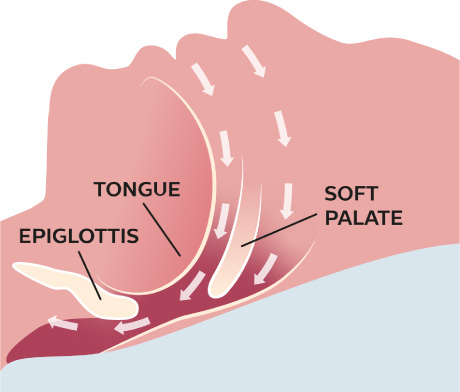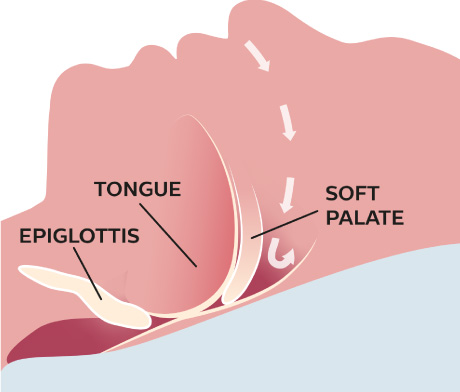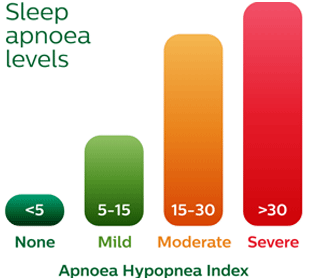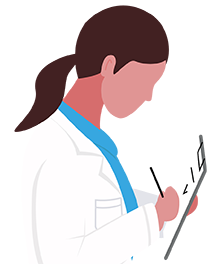OSA is a largely undiagnosed sleep disorder where a person’s upper airway repeatedly collapses during sleep causing them to stop breathing for a period of 10 seconds or longer.

Normal breathing
During sleep, air can travel freely to and from your lungs through your airways.

Obstructive sleep apnoea
Your airway collapses, stopping air from travelling freely to and from your lungs and disturbing your sleep.

How to measure sleep apnoea?
A person’s level of obstructive sleep apnoea is measured by the number of sleep interruptions per hour using the Apnoea Hypopnea Index (AHI) or the Respiratory Event Index (REI).
The 10 most common symptoms of OSA

Day-time symptoms
As you stop breathing frequently during the night, less oxygen is making its way to your brain. Low oxygen levels initiate the widening of blood vessels.
The chronic sleep deprivation caused by sleep apnoea (repeated awakenings throughout the night) can result in daytime sleepiness.
The repeated awakenings associated with obstructive sleep apnoea make normal, restorative sleep impossible; as such a person mood is impacted.
The repeated awakenings associated with obstructive sleep apnoea make normal, restorative sleep impossible; as such a person mood is impacted.
The chronic sleep deprivation caused by sleep apnoea (repeated awakenings throughout the night) can result in daytime sleepiness.

Night-time symptoms
The sound produced by vibrations in the upper respiratory airways during sleep. It is caused by partial blockage or obstructions as air is being restricted from moving easily through the airways.
An apnoea is when your upper airway closes and you stop breathing for a period of 10 seconds or longer. Your bed partner will observe this pause in breathing.
Obstructive sleep apnoea can cause your breathing to start and stop while you sleep. It can lead to the throat muscles relaxing so much that they block your airway. You may wake up abruptly gasping for air or choking.
The repeated awakenings associated with obstructive sleep apnoea make normal, restorative sleep impossible.
Obstructive sleep apnoea leads to the production of the hormone atrial natriuretic peptide, which induces the frequent need to urinate.
Sleep apnoea is bad for your health
If untreated, obstructive sleep apnoea may also increase a person’s risk of long term conditions such as:
58% of people with Type 2 diabetes have OSA. Ongoing sleep deprivation means that less hormones are produced that lower the level of blood glucose in the body after eating. The stress hormone cortisol is then released making it even harder for the body to do its job effectively.
Obstructive sleep apnoea increases the risk of heart failure by 140%.
Obstructive sleep apnoea is a sleep-related breathing disorder that has a major impact on cardiovascular function. It has been associated with hypertension, coronary artery disease, cardiac arrhythmias, sudden cardiac death, and heart failure.
50% of people with high blood pressure have OSA and 85% of people taking blood pressure medication have OSA. As oxygen levels fall your brain sends a message to the blood vessels to increase the available oxygen to the heart and brain so the body can keep functioning. This increase in blood flow puts pressure on the blood vessels’ walls, elevating levels to higher than normal even during the day while you’re awake.
70% of people who have had a stroke have sleep apnoea. CPAP therapy has proven to have beneficial effects terms of improving neurological symptoms in stroke patients. Stroke patients with OSA have a worse prognosis overall, but treatment with CPAP can have a significantly better impact on overall cognitive and other physical disabilities suffered after stroke.
Start offering your patients more with
the Pharmacy Sleep Services program
the Pharmacy Sleep Services program


















